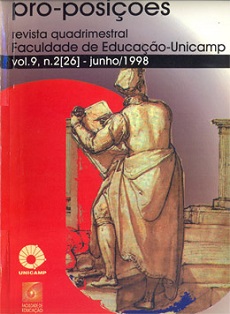Resumo
Este artigo discute algumas relações existentes entre conceitos de corpo e de dança. Alicerçado pela história da dança, desde Isadora Duncan às experiências modernas e contemporâneas Oudson Church, BiII T. Jones, Pina Bausch etc.), a autora pontua desdobramentos educacionais na área de ensino de dança decorrentes destes conceitos. Para tanto, parte de história de vida pessoal, comentando e discutindo o ensino de dança recebido desde o balé clássico às propostas de dança ditas "contemporâneas". A autora termina o artigo leventando questões sobre o corpo e a dança no mundo tecnológico e como isto pode vir a alterar e/ou contribuir com o desdobramentos de suas propostas educacionais.
Abstract:
in this article the author relates different concepts of the body and the dance in society. Based on dance history, from Isadora Duncan to modem and contemporary dance Oudson Church, BiII T. Jone, Pina Bausch), she points out some developments of a pedagogy of dance that might come from these concepts. The author's standpoint is her own !ife story learning dance in different places and with different social and cultural backgrounds, from cIassical balIet to contemporary dance. The author finishes her discussion bringing up questions about the body and the dance in technological society and how this relationship might affect and/or contribute towards the development of educational proposals in the teaching of dance.
Descriptors: Dance. Education. Body. History
Referências
Banes, S.(1987).Terpsichore in sneakers. Connecticut: Wesleyan University Press.
Banes,S.(1993).Democracy's body:judson Dance 7beater, 1962-1964.Durham: Duke University Press.
Banes,S.(1994).Writingdancing in the age q(postmodernism. Connecticut:WesleyanUniversity Press Bordo, S.(1989).The body and the reproduction of femininity: A feminist appropriation of Foucault. In: A.Jaggar and S. Bordo (Eds.). Gender/body/knowledge: Feminist reconstrnctions of being and knowing. Londres: Rutgers University Press,pp. 13-33.
Bordo, S. (1993). Unbearable weight. Berkley:University ofCalifomia Press.
Brady,J. (1982).1he unmaking q( a dancer: An unconventionall((e. NovaYork:Harper & Row.
Duncan, I . (1989). Minha Vida. Rio de Janeiro: José Olympio.
Gordon, S. (1983). q[fbalance: 1he real world q(ballet. Nova York: Pantheon Books.
Johnson, D. (1983).Body: Recovering our sensual wisdom. Berkeley:North Atlantic Books.
Kirkland, G. with Lawrence, G. (1986).Dancing on my grave. Nova York: Doubleday.
Lévy.P.(1996).O que é virtual? São Paulo: Editora 94.
Marques, L (1996). A dança no contexto: uma proposta para a educação contemporânea. Tesede doutorado. Universidade de São Paulo, São Paulo.
Marques, L (1997). A dança criativa e o mito da criança feliz, Revista Mineira de Educação Física 5(1), 28-39.
Rainer, L (1966). A quasi survey of some "minimalist" tendencies in the quantitatively minimal dance activity midst the plethora, or an analysis ofTrio A. In: R. Copeland and . Cohen (eds.) (1983). What's dance? Oxford: Oxford University Press, pp. 325- 332.
Shapiro, S. (1998). Towards transformative teachers: critica I and feminist perspectives in dance education. In: S. Shapiro (ed). Dance, power and dif.(erence. Champaign: Human Kinetics, pp. 7-21.
Shilling, C. (1993). 1he body and social theory. New York:SagePublications.
Soucy, D. (1991). Anotações de aula proferida durante o curso de extensão "D((erentes Teorias sobre Arte-Educação", promovido pelo Museu de Arte Contemporânea da USP, de 12 a 15 de maio de 1991.
Stinson, S. (1995). Uma pedagogia feminista para dança da criança, Prá-posiçõesVol. 6,3 (18), 77-89.
Stinson, S. (1998). Seeking a feminist pedagogy for children's dance. In: S. Shapiro (ed). Dance, power and d~[(erence. Champaign: Human Kinetics,pp. 2347.
Trivinho, E. ( 1994). Tendências do ano 2000. Atrator Estranho. 8.
Van Dyke, J. (1992). Modem Dance in a post modem world. Reston: American Alliance for Health, Physical Education, Recreation and Dance.
Vincent,L M. (1989).Competing with the Sylph: 7be qURStlorthepel:fect dance body. NewJersey: Dance Horizons.
A Proposições utiliza a licença do Creative Commons (CC), preservando assim, a integridade dos artigos em ambiente de acesso aberto.

